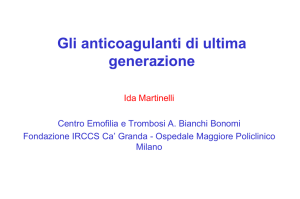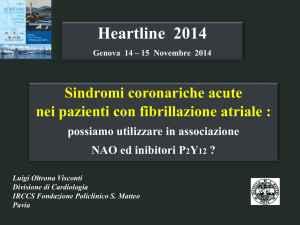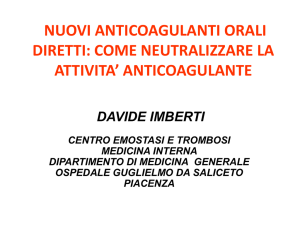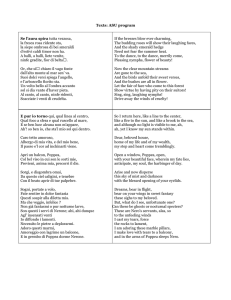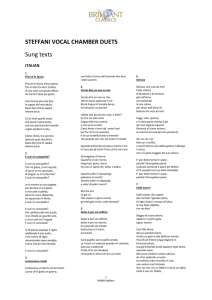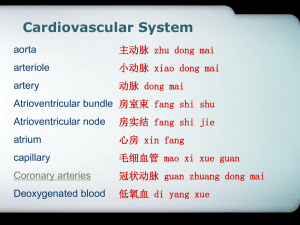Rivaroxaban
advertisement
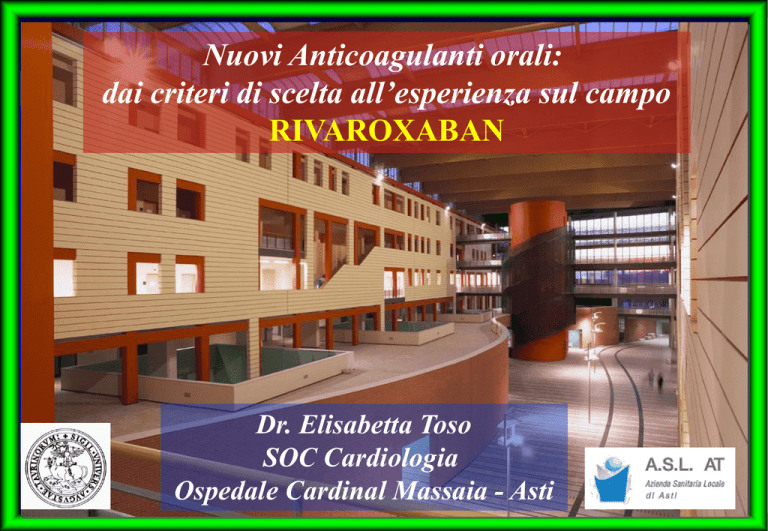
Nuovi Anticoagulanti orali: dai criteri di scelta all’esperienza sul campo RIVAROXABAN Dr. Elisabetta Toso SOC Cardiologia Ospedale Cardinal Massaia - Asti THE RIVAROXABAN HISTORY FDA Approves Rivaroxaban For NVAF, DVT and PE Oral Inhibitors Antistasin (FXa inhibitor) ROCKET-AF EINSTEIN-DVT EUROPE Approves Rivaroxaban For ACS Rivaroxaban EINSTEIN-PE ATLAS TMI 51 ACS Xabans i.v. 1905-1980 1980-1990 2000 2011-2012 Years 2013 DABIGATRAN 150 bid or 110 bid APIXABAN 5 bid or 2.5 bid RIVAROXABAN 20 or 15 od EDOXABAN 30 or 60 od Name Pradaxa Eliquis Xarelto Lixiana Target Direct IIa inhibitor Factor Xa inhibitor Factor Xa inhibitor Factor Xa inhibitor Bioavailability 7% 80% 80% 40% Half-life (T ½) 12-17 h 12 h 7-11 h 8-10 T max h 2-4 h 3-4 h 2-4 h 1-5 h Clearence 80% renal 25% renal 75% biliary 60% renal 33% biliary 40% renal Drug interaction Amiodarone () Quinidine () Verapamil () Diltiazem () Ketoconazolo() Ritonavir() Ketokonazole() Quinidine() Quinidine() Verapamil() P-gp competition CYP3A4 inhibition DABIGATRAN Coagulation tests aPTT ECT RIVAROXABAN EDOXABAN Anti-Fxa chromogenic assays PT Anti-Fxa chromogenic assays PT Anti-Fxa chromogenic assays PCC 25 U/Kg aPCC 50 IE/Kg rFVIIa 90 mcg/Kg Bleedings management Antidote APIXABAN IDARUCIZIMAB (Boehringer Ing.) RE-Verse AD study ANDEXANET ALFA (Portola) ANNEXA- A study Indications Prophylaxis Treatment VTE NVAF VTE ACS 10 mg od 15 or 20 mg od 15 mg bid 21 days 20 mg od 2.5 mg bid + antiplatelets ROCKET AF 14264 patients Mean age 73 y, 80% persistent AF, mean CHADS2 score 3.5 Stroke or systemic embolism Warfarin (2.4%/y) Rivaroxaban (2.1%/y) Days Patel et al. NEJM 2011 ROCKET AF – all-cause mortality Rivaroxaban (N=7,061) Warfarin (N=7,082) n (% per year) n (% per year) Hazard ratio (95% CI) 208 (1.9) 250 (2.2) 0.85 (0.70,1.02) Vascular death 170 (1.5) 193 (1.7) 0.89 (0.73, 1.10) Non-vascular death 21 (0.2) 34 (0.3) 0.63 (0.36, 1.08) Unknown cause 17 (0.2) 23 (0.2) 0.75 (0.40, 1.41) Endpoints All-cause mortality Hazard ratio and 95% CIs 0.2 0.5 1 Favours rivaroxaban 2 5 Favours warfarin Safety population – on-treatment analysis Patel MR et al, NEJM 2011. ROCKET AF – bleeding analysis Rivaroxaban (N=7,111) Warfarin (N=7,125) n (% per year) n (% per year) Hazard ratio (95% CI) Principal safety endpoint 1,475 (14.9) 1,449 (14.5) 1.03 (0.96,1.11) Major bleeding 395 (3.6) 386 (3.4) 1.04 (0.90,1.20) Haemoglobin drop (≥2 g/dl) 305 (2.8) 254 (2.3) 1.22 (1.03,1.44)* Transfusion 183 (1.6) 149 (1.3) 1.25 (1.01,1.55)* Critical organ bleeding 91 (0.8) 133 (1.2) 0.69 (0.53,0.91)* 55 (0.5) 84 (0.7) 0.67 (0.47,0.93)* 27 (0.2) 55 (0.5) 0.50 (0.31,0.79)* 1,185 (11.8) 1,151 (11.4) 1.04 (0.96,1.13) Parameter Intracranial haemorrhage Fatal bleeding Non-major clinically relevant bleeding Major bleeding from gastrointestinal site (upper, lower and rectal): rivaroxaban=224 events (3.2%); warfarin=154 events (2.2%); p<0.001* Safety population – on-treatment analysis; *Statistically significant Hazard ratio and 95% CIs 0.2 0.5 1 Favours rivaroxaban 2 5 Favours warfarin Patel MR et al, NEJM 2011. What about Rivaroxaban and.. VALVULAR HEART DISEASE HYPERTROPHIC CARDIOMYOPATHY ELECTRICAL CARDIOVERSION NOACs for VALVULAR HD ESC AF Guidelines European Heart Journal 2012 Patients with prosthetic heart valves should not take dabigatran/rivaroxaban/apixaban nor should pts with AF that is caused by a heart valve problem. www.fda.gov ¨ nt er Br eit har dt 1* , H elm ut Baum gar t ner 2, Scot t D. Ber kowit z 3, A nne S. H ellkam p 4, Gu Jonat han P. Piccini 4, Susanna R. St evens4, Yuliya Lokhnygina4, Manesh R. Pat el 4, Jonat han L. H alper in 5, Daniel E. Singer 6, Gr aem e J. H ankey 7, W er ner H acke8, Richar d C. Becker 4, Chr ist opher C. N essel 9, Kennet h W . Mahaffey 10, Keit h A . A . Fox 11, and Rober t M. Califf 12, for t he RO CKET A F St eer ing Com m it t ee & Invest igat or s Valvular Heart Disease 1992 pts (14%) 90% mitral regurgitation (only 3% post-rheumatic) 1 Stroke or SE Major Bleedings Department of Cardiovascular Medicine, Division of Electrophysiology, University Hospital Mu ¨ nster, Von-Esmarch-Str asse 117, Mu ¨nster D-48149, Germany; 2Department of Cardiovascular Medicine, Division of Adult Congenital and Valvular Heart Disease, University Hospital Mu ¨nster, Mu ¨ nster, Germany; 3Bayer Healthcare Pharmaceuticals, L.P., W hippany, NJ, USA; 4Duke Clinical Research Institute, Duke University Medical Center, Durham, NC, USA; 5The Cardiovascular Institute, Mount Sinai Medical Center, New York, NY,USA; 6Clinical Epidemiology Unit, General MedicineDivision,Massachusetts General Hospital,and Harvard Medical School,Boston, MA,USA; 7School of Medicine and Pharmacology, TheUniversity of Western Australia, Perth, Australia; 8Ruprecht-Karls-University, Heidelberg, Germany; 9Johnson & Johnson Pharmaceutical Research & Development, Raritan, NJ, USA; 10Department of Medicine, Stanford University, Stanfor d, CA, USA; 11University of Edinburgh, and Royal Infirmary of Edinburgh, Edinburgh, UK; and 12Duke Translational Medicine Institute, Duke University Medical Center, Durham, NC, USA 6,14 2,43 Received 27 February 2014; revised 11 June 2014; accepted 16 July 2014 2,01 • Rivaroxaban • Warfarin % Events/100 pts/y % Events/100 pts/y P 0,76 P 0,01 4,20 We investigated clinical characteristics and outcomes of patients with significant valvular disease (SVD) in the Rivaroxaban Once Daily Oral Direct Factor Xa Inhibition Compared with Vitamin K Antagonism for Prevention of Stroke and Embolism Trial in Atrial Fibrillation (ROCKET AF) trial. ..................................................................................................................................................................................... M et hods ROCKET AFexcluded patientswith mitral stenosisor artificial valveprostheses.Weused Cox regression to adjust comparand r esul t s isonsfor potential confounders.Among14 171patients,2003(14.1%) hadSVD;theywereolder andhadmorecomorbidities than patients without SVD. The rate of stroke or systemic embolism with rivaroxaban vs. warfarin was consistent among patients with SVD [2.01 vs. 2.43%; hazard ratio (HR) 0.83, 95% confidence interval (CI) 0.55–1.27] and without SVD (1.96 vs.2.22%;HR0.89, 95%CI 0.75–1.07;interaction P¼ 0.76). However,ratesof major and non-major clinically relevant bleedingwith rivaroxabanvs.warfarin werehigher in patientswith SVD (19.8%rivaroxaban vs.16.8%warfarin;HR1.25,95% CI 1.05–1.49) vs. those without (14.2%rivaroxaban vs. 14.1%warfarin; HR1.01, 95%CI 0.94–1.10; interaction P¼ 0.034), even when controlling for risk factors and potential confounders. In intracranial haemorrhage, there was no interaction between patients with and without SVD where the overall rate waslower amongthose randomized to rivaroxaban. ..................................................................................................................................................................................... Conclusions Many patients with ‘non-valvular atrial fibrillation’ have significant valve lesions. Their risk of stroke is similar to that of A im s Downloaded from http://eurheartj.oxfordjournals.org/ at BIBLIOTECHE BIOMEDICHE UNIVERSITA' DEGLI STUDI DI TORINO on September Clinical char act er ist ics and out com es wit h r ivar oxaban vs. war far in in pat ient s wit h non-valvular at r ial fibr illat ion but under lying nat ive m it r al and aor t ic valve disease par t icipat ing in t he ROCKET AF t r ial Breithardt G. et al Eur Heart Journal 2014 • In HCM pts CHA2DS2VASC score to calculate stroke risk is not recommended • There are no data on the use of NOACs in HCM pts What about Rivaroxaban and.. VALVULAR HEART DISEASE HYPERTROPHIC CARDIOMYOPATHY ELECTRICAL CARDIOVERSION Electrical Cardioversion on warfarin Sintomatic cerebrovascular complications 13/ 5247 pts 0.24% 0.7% 0.5% 0.4% 0.3% 0 1841 pts 664 pts 521 pts 275 pts 1946 pts Electrical Cardioversion on NOACs Sintomatic cerebrovascular complications CHADS 3.5 1.6% 9/1708 pts 0,52% CHADS 2.1-2.2 0.8% CHADS 2.1 0.30% 0 647 pts 672 pts Nagarakanti R et al Circulation 2011 265 pts Piccinini et al JACC 2013 265 pts Flaker G. et al JACC 2014 Rivaroxaban vs. vitamin K antagonists for cardioversion in atrial fibrillation 1504 Riccar do Cappat o 1†, Michael D. Ezekowit z 2†* , Allan L. Klein 3, A. John Cam m 4, X-VERT Trial patients, 141 Centres across 16Le countries Chang-Sheng Ma5, Jean-Yves Heuzey 6, Mar io Talajic 7, Maur ´ıcio Scanavacca8, Panos E. Var das9, Paulus Kir chhof 10,11,12, Melanie Hem m r ich 13, Vivian Lanius14, Isabelle Ling Meng13,Finland Pet er W ildgoose15, Mart in van Eickels13, and Stefan H. Hohnlose UK on behalf of the X -VeRT Investigators Italy: • • • • Canada USA Botto GL Calò L Cappato R Capucci A Netherlands Denmark Arrhythmia and Electrophysiology Center, University of Milan, IRCCSPoliclinico San Donato, San Donato Milanese, Milan, Italy; 2TheSidney Kimell Medical College at Thomas Germany Belgium University,1999 Sproul Rd,Suite 25,Broomall, PA 19008,USA; 3Department of Cardiovascular Medicine,Cleveland Clinic Heart and Vascular Institute, Cleveland, OH,USA; 4D France Clinical Sciences, St George’s, University of London, London, UK; 5Cardiology Division, Beijing AnZhen Hospital, Capital Medical University, Beijing, China; 6Division of Cardio Portugal ˆ pital Europe´enGeorgesPompidou, Universite´ ParisVRene´ -Descartes, Paris, France; 7Department of Medicine, Research Center,Montreal Heart Institute, U Arrhythmology,Ho de Montre´al, Montreal, Canada; 8Arrhythmia Clinical Greece Unit of Heart Institute (InCor), University of Sa˜ o Paulo Medical School, Sa ˜ o Paulo, Brazil; 9Department of Cardiology, H Spain 10 China University Hospital, Heraklion (Crete),Greece; Centrefor Cardiovascular Sciences, School of Clinical and Experimental Medicine,University of Birmingham, Birmingham, UK; NHSTrust, Birmingham, UK; 12Department of Cardiovascular Medicine, Hospital of the University of Mu¨ nster, Mu¨ nster, Germany; 13Global Medical Affairs, Bayer HealthCar Germany; 14Global Research and Development Statistics,Bayer HealthCare, Berlin, Germany; 15Janssen Scientific Affairs, LLC,Raritan,NJ,USA;and 16Department of Cardiology of Clinical Electrophysiology, J.W. Goethe University, Frankfurt, Germany 1 • Gaita F • Grimaldi M • Gulizia MM X-VeRT isthefirst prospectiverandomized trial of anovel oral anticoagulant in patientswith atrial fibrillation unde • Themistoclakis S elective cardioversion. Received 23 July 2014; revised 7 August 2014; accepted 11 August 2014 Singapore A im s ............................................................................................................................................................................ South Africa M et hods Weassigned1504patientsto rivaroxaban(20 mgoncedaily,15 mgifcreatinineclearancewasbetween30and49 m and r esult s or dose-adjustedvitaminKantagonists(VKAs) ina2:1ratio.Investigatorsselectedeither anearly(target periodof1– after randomization) or delayed (3–8 weeks) cardioversion efficacyoutcomewasthecompo Cappato R. strategy.Theprimary et al. Eur Heart Journal 2014 stroke, transient ischaemic attack, peripheral embolism, myocardial infarction, and cardiovascular death. The p Randomized, open-label, parallel-group, active-controlled multicentre study Inclusion criteria: R 2:1 Cardioversion strategy 1–5 days VKA Rivaroxaban 20 mg od* Delayed R 2:1 ≥21 days (max. 56 days) VKA Rivaroxaban 20 mg od* 42 days VKA Rivaroxaban 20 mg od* 42 days End of study treatment Early# Cardioversion Rivaroxaban 20 mg od* Cardioversion Age ≥18 years, non-valvular AF lasting >48 h or unknown duration, scheduled for cardioversion OAC 30-day follow-up VKA *15 mg if CrCl 30–49 ml/min; VKA with INR 2.0–3.0; #protocol recommended only if adequate anticoagulation or immediate TEE Ezekowitz MD et al. Am Heart J 2014;167:646–652; X-VeRT: clinical characteristics Total (N=1504) Rivaroxaban (n=1002) VKA (n=502) 64.9 ±10 64.9±10 64.7±10 Male, % 72.7 72.6 73.1 Persistent 53.9 55.9 50.0 Hypertension, % 66.2 65.0 68.7 Renal function/CrCI, % ≥80 ml/min 60.2 61.5 57.6 Prior OAC use for ≥6 weeks, % 42.8 42.3 43.8 7.7 6.7 9.8 CHADS2 score, mean SD 1.4±1.1 1.3±1.1 1.4±1.1 CHA2DS2-VASc score, mean SD 2.3±1.6 2.3±1.6 2.3±1.6 Age, mean SD, years Previous stroke/TIA or SE, % Cappato R et al. Eur Heart J 2014 X-VeRT: Stroke or TIA 768/872 early CV performed 399/632 delayed CV performed 1,08% 0,9% 0.7% 0.2% 567 pts 277 pts 321 pts 78 pts Cappato R et al. Eur Heart J 2014 X-VeRT: time to cardioversion Patients cardioverted as scheduled p<0.001 Delayed cardioversion Patients (%) Rivaroxaban: 841/1002 pts (84%) Warfarin: 385/502 pts (77%) 1 patient with inadequate anticoagulation 95 patients with inadequate anticoagulation Rivaroxaban: 321/417 pts (77%) Warfarin: 78/215 pts (36.3%) Cappato R et al. Eur Heart J 2014 X-VeRT: time to cardioversion Median time to cardioversion 100 80 Days The time between randomization and CV was similar or shorter in Rivaroxaban vs Warfarin Early median 1 (1-2 ) vs 1 (1-3) Delayed 22 (21-26) vs 30 (23-42) Rivaroxaban VKA 60 p<0.001 p=0.628 40 22 days 20 0 Early 30 days Delayed Cappato R et al. Eur Heart J 2014 Thanks for your attention! Thrombosis Research Global Forum 2014, Berlin 6-8 November
